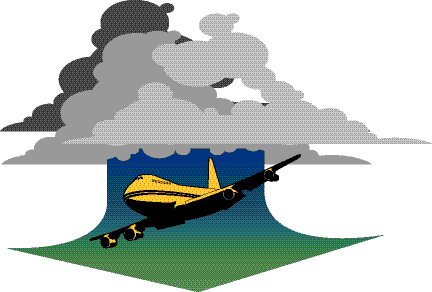
Information found in both written
and verbal clearances is frequently subject to misinterpretation. In our
first ASRS report, instructions in a published procedure were treated
as a clearance by a corporate crew.
- We were
cleared for the VOR arrival. We were at FL310 and had already programmed
the "expect-crossing-altitude" of 17,000 feet at the VOR [according
to the published arrival procedure]. When the altitude alerter sounded,
I advised Center that we were leaving FL310. He acknowledged with a
"Roger." At FL270, Center quizzed us about our descent. I
told him we were descending so as to cross the VOR at 17,000 feet. He
advised us that we did not have clearance to descend. What we thought
was a clearance was in fact an "expect" clearance.
We are both experienced pilots...which just means that experience is
no substitute for a direct question to Center when you are in doubt
about a clearance. Also, the term "Roger" only means that
he received the transmission, not that he understood the transmission.
The Aeronautical
Information Manual (AIM) Section 5-4-1 indicates that "Expect"
altitudes are published for planning purposes. "Expect" altitudes
are not considered crossing restrictions until verbally issued by ATC.
Another crew fell victim to
an apparent readback/hearback error, which resulted in confusion about
the clearance, and ultimately, to inadequate separation from another aircraft.
- Departing
IFR, clearance was to maintain 5,000 feet, expect 12,000 in ten minutes.
After hand-off to Center...we understood and read back, "Leaving
5,000 turn left heading 240° for vector on course." First Officer
turned to assigned heading climbing through 5,000 feet. At 5,300 feet
Center advised assigned altitude was 5,000 feet. We immediately descended
to 5,000. Center then informed us we had traffic at 12 o'clock and a
mile at 6,000. After passing traffic, a higher altitude was assigned
and climb resumed.
In the cockpit, the words "reaching" and "leaving"
sound much alike. We now believe the clearance was probably "reaching
5,000, etc." Even our readback to the controller with "leaving"
didn't catch the different wording.
"Reaching" and "leaving"
are commonly used ATC terms having different usages. They may be used in
clearances involving climbs, descents, turns, or speed changes.
Eye on the
Sky
An air taxi pilot credits ATC
with a "save" - and his ADF needle with a lesson about weather-induced
effects:
- On a deadhead
leg, I had received the assigned heading to intercept the final approach
for a straight-in NDB approach. Upon turning final, the controller told
me to switch to Tower. At that moment the ADF needle quickly began to
fall and I reported my position to the Tower as being over the final
approach fix. The Tower then cleared me to land and I started my descent
to MDA. I had descended 200 feet when I noticed my ADF needle was now
pointing toward the nose of the airplane. I immediately leveled off
and the Tower advised me to contact Approach. The Approach Controller
advised me I was left of course and that the minimum altitude was 2,100
feet. He gave me a heading to re-establish me on final. I climbed from
1,900 feet to 2,100 feet and was switched back to the Tower Controller.
This time I had true station passage and started my descent to MDA and
completed the approach with no further problems.
Contributing factors: Static (weather-induced) interference on the ADF
needle, and the ILS and DME out-of-service. Many thanks to the effort
of the controllers. Nice to know they keep an eye on those in the sky.
Before the advent of on-board
weather radar systems, pilots flying near an area of thunderstorm activity
would tune their ADFs to a low frequency and watch where the needle pointed.
They avoided areas where the needle pointed (indicating thunderstorm-induced
static).
ATC also kept an eye on an
air carrier crew, who almost followed their ADF needle to the wrong airport.
- Cleared
for the visual approach at XYZ. All navaids were tuned and idented for
XYZ. I observed bright runway lights with proper orientation. A quick
glance at the map display and needle point on the ADF suggested that
it was the right airport. The First Officer agreed. We descended to
approximately 400 feet when XYZ Tower advised us that we were on final
for ABC [about 3 miles short of XYZ]. We initiated a go-around.
The ABC runway lights loomed bright and clear with proper orientation.
XYZ lights were not as obvious.
A cross-check of other available
navigational aids might have given the crew contradictory information, motivating
them to seek clarification from ATC.

- Operations
delayed us on the ground for over an hour due to
 thunderstorms approaching our destination. By the time we did get there,
the thunderstorms were still overhead the field. We were being vectored
for Runway 8, then for Runway 9. By now we were in the "get it
on the ground" mode. [Then] the ILS went down due to a lightning
strike. We followed someone else's lead and called for a visual approach
in marginal VFR. On final at 500 feet, Tower called the winds at 230
degrees at 17 knots. This was greater than 10 knots of tailwind and
on a very wet runway. But in the mindset we were in, rational thought
did not appear.
thunderstorms approaching our destination. By the time we did get there,
the thunderstorms were still overhead the field. We were being vectored
for Runway 8, then for Runway 9. By now we were in the "get it
on the ground" mode. [Then] the ILS went down due to a lightning
strike. We followed someone else's lead and called for a visual approach
in marginal VFR. On final at 500 feet, Tower called the winds at 230
degrees at 17 knots. This was greater than 10 knots of tailwind and
on a very wet runway. But in the mindset we were in, rational thought
did not appear.
The Captain struggled with windshear all the way down, and floated it
halfway down the runway before touchdown. One reverser didn't deploy
and the other was drifting us off centerline. Now on brakes only, we
stopped in the last 1,000 feet of rain-soaked, rubber-deposited runway.
It was "shear" luck
that this aircraft didn't roll off the end of the runway.
Windshear can come as a big
surprise even when the crew is prepared for it, as an air carrier Captain
reports:
- [While we
were still at the gate], winds were reported at 260 degrees at 26-35
knots. Windshear loss of 15 knots had been reported by landing aircraft.
By pushback and taxi-out, wind was reported at 070 degrees at 4 knots.
The last aircraft to land prior to our departure reported no turbulence
or airspeed loss. Takeoff...was normal. At approximately 600-800 feet
AGL, windshear was annunciated, both visually and aurally, by the windshear
warning system. Airspeed dropped instantly by 25-30 knots to below V2.
The altimeter stopped showing a climb and the vertical speed indicator
showed a 300-foot-per-minute descent. I firewalled the engines. It took
about 5-10 seconds for the aircraft to climb or accelerate.
The
First Officer adds: "Even though
we had talked about it during taxi-out, flying into a windshear is an
eye-opening experience. Having had windshear training repeatedly in
the simulator over the last few years really made the difference."
The crew's awareness of the windshear
and training to counteract it were the keys to a safe outcome in this incident.
Uncontrolled
Shouldn't Mean Uncommunicative
Radio communications at uncontrolled
airports are sometimes less than optimal in quality and quantity. An air
carrier Captain reports that an unclear position report from a tow aircraft
at a non-Tower airport almost led to a ground collision.
- [Approaching
from the southwest], we were on a 5-mile final for Runway 09 at ABC,
and UNICOM mentioned that a glider was preparing to leave for Runway
27. The tow pilot said they would be ready in 2 minutes. We thought
this meant that the glider and tow were holding short, since no word
was said that the aircraft were actually on Runway 27. We radioed that
we would continue for Runway 09. No one said anything else.
While touching down on Runway 09, we saw the glider at the fixed distance
markers of Runway 27. Fortunately there was enough room to stop safely
before reaching the glider. After our plane was parked, I talked with
the people at the FBO, explaining that "in preparation for Runway
27" sounds like the aircraft were holding short, and that it would
be helpful to clearly state that the glider is on the runway so that
there would be no mistake. ABC is in mountainous terrain and is a challenging
airport to service. When in doubt, circle.
UNICOM operators may not be able
to provide all the information an inbound pilot needs, and sometimes may
not even have a clear view of the runways. In addition, prudence would suggest
that a flight crew discontinue their straight-in approach when faced with
soon-to-depart opposite direction traffic.
A report from a general aviation
pilot describes how lack of radio communication at an uncontrolled airport
led to near-disaster.
- I called
on UNICOM for landing on Runway 09, and made a call entering base. On
final, I had a red and white light on the VASI, and at approximately
100-150 feet AGL, I just caught sight of a helicopter low and left of
me, coming up. I tried to pull up to the right, but the helicopter's
rotor impacted my left flap and left horizontal stabilizer. I made an
uneventful landing. I did not hear any radio calls from the other aircraft.
The helicopter should have made position calls. Additionally, crossing
the approach end of an active runway should not be done at glide-slope
altitude. This just shows that [a mid-air collision] can happen anywhere
in a traffic pattern.
One wonders what the helicopter
pilot was thinking when crossing the approach end of the runway, as reported.
However, pilots should also keep in mind that radios are not required at
uncontrolled airports, and that many aircraft are not radio-equipped.


![]()

![]()
 thunderstorms approaching our destination. By the time we did get there,
the thunderstorms were still overhead the field. We were being vectored
for Runway 8, then for Runway 9. By now we were in the "get it
on the ground" mode. [Then] the ILS went down due to a lightning
strike. We followed someone else's lead and called for a visual approach
in marginal VFR. On final at 500 feet, Tower called the winds at 230
degrees at 17 knots. This was greater than 10 knots of tailwind and
on a very wet runway. But in the mindset we were in, rational thought
did not appear.
thunderstorms approaching our destination. By the time we did get there,
the thunderstorms were still overhead the field. We were being vectored
for Runway 8, then for Runway 9. By now we were in the "get it
on the ground" mode. [Then] the ILS went down due to a lightning
strike. We followed someone else's lead and called for a visual approach
in marginal VFR. On final at 500 feet, Tower called the winds at 230
degrees at 17 knots. This was greater than 10 knots of tailwind and
on a very wet runway. But in the mindset we were in, rational thought
did not appear.